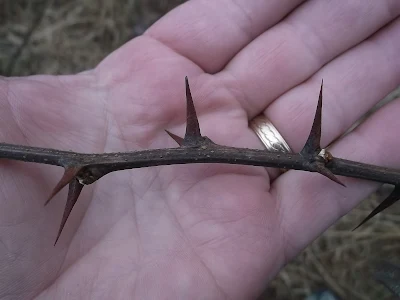I was pruning trees today.
Apples
 |
| This image was photographed in my orchard at the end of July. The combination of heavy fruit set and long branches necessitated my propping up the limbs. |
But small trees also produce more fruit per square foot of orchard space, assuming you plant the trees at appropriate distances apart.
 |
| In this model, the diameter of the limb at any given point is (32*distance from weight(inches)*weight/Pi/allowable stress) ^ 0.333 |
This is a chart showing the amount of "wood" a tree would have to invest in to hold a pound of apples out in space. The horizontal axis is the number of inches the cluster of apples is held from the trunk. The vertical axis is the number of pounds of "wood" required to hold those apples out there. I used 40 pounds per cubic foot for the wood density and 400 psi as the working strength of the wood.
Clearly, the carbohydrates invested in growing wood cannot be used to ripen apples.
So a tree with 24 inch limbs would invest 0.2 pounds of carbs to hold a pound of apples out in space. That same tree would have to invest 0.6 pounds of carbs to hold that pound of apples 48 inches from the trunk. While 0.6 pounds to hold one pound of apples does not sound like too bad of a deal, you have to remember that 0.6 pounds of carbs equates to about 4 pounds of apples due to the water-weight of those apples.
Clearly, there are many simplifications in this analysis. Most apple trees set fruit throughout the canopy and not just at the ends of the branches. Also, the tree invests those resources over several seasons.
 |
| I took a pretty fair amount of wood out of the trees. |
 |
| It is a popular misconception that "dwarf" trees stay dwarf on their own. Wrong. All trees grow. It is simply easier to keep dwarf trees smaller. |
 |
| Dwarf trees grow so slowly that they collect moss and lichens. This is from a tree grafted on M-9. This is actually a very artsy picture if you zoom in on the lichens. There is a universe of detail. |
 |
| Trees that grow more vigorously tend to shed bark plates and shuck off the lichens and mossy parts. This tree had dwarf roots but the scion rooted because it was planted too deeply. |
Black Locust
I don't know what it is about Black Locust thorns. I have an adverse reaction to them when I get stuck. My hands are swollen up. No other thorny plant affects me that way. I don't know if it is allergy or bacterial or small parts of the thorns breaking off?
I just don't know.


The smaller trees are also easier to pollinate... And that thorn looks NASTY!
ReplyDeleteThe smaller trees are also easier to pollinate... And that thorn looks NASTY!
ReplyDeleteI have a reaction when those thorns poke me, too. More of a burning sensation that lasts way longer than I'd expect from a poke from a thorn.
ReplyDelete